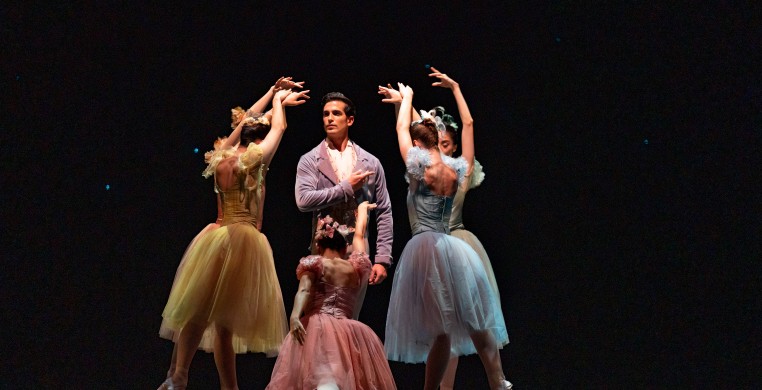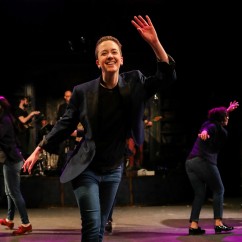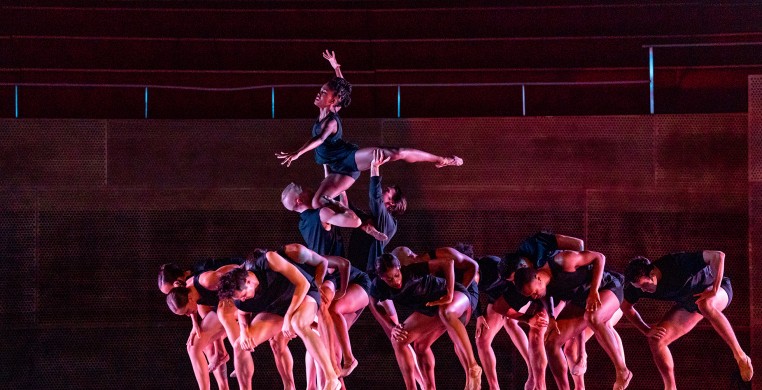The 32nd Gala performance of “Dance for Life” rocked the walls of Chicago’s Auditorium Theatre, packed to the gills with a cross-section of glitterati from the dance world, high society, Chicago politics, dance-lovers, donors, cheerleaders, dance students, and dance companies. The mood was festive, the energy electrifying, both on stage and in the audience.
“Dance for Life,” is the annual benefit performance of its parent fundraising organization, Chicago Dancers United (CDU), which works tirelessly year-round to meet the healthcare needs of professionals in the dance industry. They include dancers, choreographers, artistic directors, stagehands, technical directors, costume, set, and lighting designers, musicians, teachers and composers.
“As One” (2021), Randy Duncan’s finale for this year’s Gala, which took place last Saturday night, August 19, couldn’t have been a more fitting conclusion to an evening that spanned a diversity of dance genres, from ballet to hip-hop, jazz and African to modern dance and contemporary.
Ira Antelis’s music and lyrics to “As One,” epitomize the unique camaraderie, collaboration, and mutual care the Chicago dance community has developed over the past 32 years of the Gala’s existence.
In these conflicting times of upheaval and dissension locally, nationally, and internationally, multiple levels of meaning resonate with the dancers’ chanting: “What do we want? Down with hate!!” and “All together as one, show the world the time has come!” They seem to be saying that Art can make a difference in changing the thoughts, beliefs, and actions of people. Like the ripples in a pond, art can change the world. This year’s “Dance for Life” rekindled my hope. We have only to look at the transformative effect of great movements in the performing and visual arts to see that this is true throughout world history.
It’s not an exaggeration to say that “Dance for Life” and CDU have been an integral factor in transforming Chicago’s dance community into a role model for the rest of the country, as well as making Chicago a national and international hub for dance. For all of these reasons and more (read on!), “Dance For Life” is THE go-to event of the year, bar none.
The program began with The Joffrey Ballet’s performance of excerpts from Gerald Arpino’s “Birthday Variations” (1986). A technical showcase for six stellar Joffrey ballerinas, each with charm and virtuosity all her own, each in a different color knee-length tu-tu. At first, it seemed like a cluster of many fluffy girls and one aberrant man as Prince Consort (Alberto Velazquez) who came in handy now and then to hold one of them.
 Alberto Velazquez, Yumi Kanazawa, Amanda Assucena, Valeria Chaykina and Gayeon Jung in Joffrey Ballet's "Birthday Variations"; Photo by Cheryl Mann
Alberto Velazquez, Yumi Kanazawa, Amanda Assucena, Valeria Chaykina and Gayeon Jung in Joffrey Ballet's "Birthday Variations"; Photo by Cheryl Mann
It soon became apparent that there was more to the birthday party than that. Two unfortunate ladies polished the Auditorium’s slippery stage floor with spills, but showed grace and poise, and even a little playful humor rebounding quickly. Their melty arms and willowy upper-torso flow sailed above some of the most diabolically difficult point work I’ve ever witnessed, such as skips en ménage, sissones, and a “look- Mom-no-hands” penché arabesque, all executed while balancing on the tiny tip of a pink satin toe shoe.
Expansive leaps, and pas de chats, and a series of rapid-fire soutenu turns dazzled. No tour de force showcase would be complete without a ballerina’s requisite 32 fouetté turns en pointe, which brought down the house with bravo’s and clapping. In the end, Velazquez’s Prince Consort got his day in the sun too, with a stellar demonstration of effortless tours en l’airs” and entre chat huits. “Birthday Variations” was every little girl’s dream birthday party, and a delicious taste of grown-up ballet.
BOOMCRACK! Dance Company is all about the beat and squiggles, swaying bodies and drapey limbs interrupted by sudden plunges that punctuated this all-women’s “get outa my way” statement of self actualization.
“Luminescence.” (2023), the Giordano/South Chicago Dance Theatre collaboration, began in silence with a single woman in turquoise on stage, perhaps a symbolic Pandora or Delphic oracle who sees what others do not. Tense muscles and labored gestures convey agony, distress, agitation. Couples emerge saving each other from falling. Arms and legs stab the space with sharp accents that melt into a liquid scene, dancers swimming toward each other, saving each other with love. Kia Smith’s choreography for the joint effort brought what seemed like a cast of thousands together for this apocalyptic vision of redemption. The dancers, dressed in jeans, follow their oracle through a maze toward deliverance, at first in silence, the only accompaniment their own slapping thighs, hand claps, percussive “HAH”s, and rhythmic foot stomps. They enact a ritual birth, peeling out of circular formations in layers of blossoming limbs. The lyrical flow of music by Coldplay and U2 gives “Luminescence.” a dream-like feel, with a seamless blend of modern dance, jazz, and ballet idioms. In the end, the lyric, “It’s a beautiful day” lands us in a feel-good place. Perfect for “Dance for Life.”
Moonwater Dance Project offered “Clarity” (2022), a work in two parts for five women in bras and white tights, the first part lyrical and dreamy, the second percussive and high energy, with movement alternating between collapsing and jerky, mechanical gestures, and melting and sliding to still poses.
Chicago Tap Allstars began with the entire collection of dancers from all the major tap companies in town keeping the beat “a cappella.” Various configurations of solos, duets, trios, and larger ensembles made fluid entrances and exits, blending and separating and reconvening for a rhythmic glorification of tap en masse. Tap veterans Bril Barrett and Mark Yonally choreographed and took rhythmically complex solo turns, along with ‘Star’ Dixon, whose style and stage personality light a fire under her feet.
 Molly Smith and the dancers of the Chicago Tap Allstars at Dance For Life 2023; Photo by David Harmantas
Molly Smith and the dancers of the Chicago Tap Allstars at Dance For Life 2023; Photo by David Harmantas
Muntu Dance Theatre opened Act Two with rafter-shattering drums carving sound corridors down the two center aisles of the house. As they made their way to the stage to perform an excerpt from “Djeliya,” with Muntu’s dancers, we knew we were in for something completely different. The non-stop energy and excitement and the earthiness and raw celebration of the human body raised the roof beams and heart rates of the entire theatre.
David Dawson’s tender duet, “On The Nature of Daylight” (2007), performed by independent artists Joseph Massarelli and Riho Sakamoto, showcased the dancers’ exquisite rapport and brilliant artistry.
What could possibly follow such sublime lyricism? Homer Hans Bryant’s Hiplet Ballerinas in Trevon Lawrence and Anthony Sampson’s “React” (2021). Channeling “Swan Lake” and the cygnettes, they brought fun and laughs with their sudden shift to sass on point to the music of The Pussycat Dolls.
 Rhythm and movement abound in Muntu Dance Theatre at Dance For Life 2023; Photo by by Marc Monaghan
Rhythm and movement abound in Muntu Dance Theatre at Dance For Life 2023; Photo by by Marc Monaghan
Saving Hubbard Street’s excerpt from Aszure Barton’s “BUSK” (2009) for the end of the program was one of the more brilliant strokes of the evening’s orchestration, because the only thing that could possibly follow it was Randy Duncan’s finale. “BUSK” gives insight into Barton’s unique choreographic voice. Her movement invention, structural concepts, and spatial design are unlike anything I have ever experienced. “Busk” is truly an epic work, and Barton is a major innovator of dance theater for our times. The piece builds episodically to a sense of culmination and solidarity. Not without some whimsy, Barton creates rhythms in spatial counterpoint to the music, somewhat reminiscent of Karl Orff’s Carmina Burana. A ritualistic quality pervades much of the repetitive movement themes and interactions. The piece ends with all the dancers jumping as lights fade to black, leaving us with a literal cliff-hanger.
What a grand night! Hooray for Chicago Dance! Hooray for “Dance for Life!”
“Dance For Life” is the brainchild of Keith Elliott, former dancer with Joseph Holmes Dance Theatre, and Harriet Ross, who was the company’s artistic director. Joseph Holmes’ tragic death from AIDS spurred Elliott to organize a grass-roots effort in the dance community, enlisting fellow dancers, choreographers, and dance companies to donate their time and talent for a one-time benefit performance that would raise funds to help professionals in the dance industry who were stricken with the disease. It was Ross who encouraged him to make “Dance For Life” an annual event. In 1992, Elliott teamed up with Todd Keich for the first official Dance for Life” performance. Ross, along with Gail Kalver, then Executive Director of Hubbard Street, have been integral to the success of “Dance For Life” and the establishment of its Parent organization, Chicago Dancers United.

